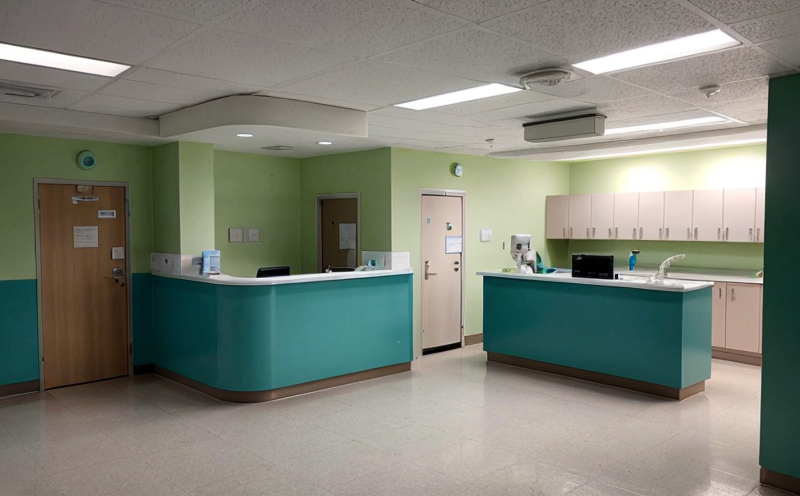CDC Legionella Testing in Hospital Water Systems
The Centers for Disease Control and Prevention (CDC) has established stringent guidelines to prevent the spread of Legionnaires' disease, a severe form of pneumonia caused by Legionella pneumophila. This infectious bacterium thrives in warm water systems, making hospital water systems particularly vulnerable. Proper testing is essential not only for compliance with CDC standards but also to ensure patient safety and maintain public trust.
Hospitals must continuously monitor their water systems to detect Legionella contamination. This involves collecting water samples from various points in the system, including showers, faucets, cooling towers, and evaporative condensers. Once collected, these samples are analyzed using culture-based methods or molecular techniques such as PCR (Polymerase Chain Reaction) to identify Legionella species.
The CDC recommends a comprehensive approach that includes:
- Prevention measures: Implementing water management programs, controlling biofilm, and maintaining appropriate temperatures in the system.
- Regular monitoring: Conducting periodic testing to ensure compliance with CDC guidelines.
- Response protocols: Having a plan for immediate action if Legionella is detected.
The key challenge in Legionella testing lies in the complexity of hospital water systems and the need for accurate detection. Culture-based methods, while reliable, can take several days to yield results, whereas molecular techniques like PCR offer faster turnaround times but require meticulous sample preparation and interpretation.
Accurate and timely identification is critical because even a single case of Legionnaires' disease in a hospital setting can have severe consequences for patient health. Hospitals must adhere strictly to CDC guidelines to maintain their reputation as safe environments for both patients and staff.
Scope and Methodology
The scope of CDC Legionella testing includes the identification, detection, and quantification of Legionella pneumophila in hospital water systems. This service involves:
- Sampling: Collecting water samples from critical points in the system.
- Preparation: Processing the samples to ensure they are suitable for analysis.
- Analysis: Utilizing culture-based or molecular methods to identify Legionella.
- Reporting: Providing detailed reports that include sample identification, method used, results, and recommendations for action.
The methodology adheres strictly to CDC guidelines and international standards such as ISO 12549-3:2017, which provides protocols for the recovery of Legionella pneumophila. Culture-based methods involve incubating samples in specialized media that promotes the growth of Legionella. Molecular techniques, on the other hand, use PCR to amplify and detect Legionella DNA directly from the sample.
The choice between culture-based and molecular methods depends on factors such as turnaround time requirements and budget. Culture-based methods are more labor-intensive but provide a definitive identification of the organism. Molecular techniques are faster but require careful validation to ensure accurate results.
Benefits
- Patient Safety: Ensures that hospital water systems do not pose a risk for Legionnaires' disease.
- Compliance: Meets CDC and other regulatory requirements to prevent outbreaks.
- Reputation: Maintains the hospital's reputation as a safe environment for patients and staff.
- Patient Trust: Enhances patient confidence in the hospital’s commitment to safety and quality care.
- Early Detection: Facilitates timely interventions before an outbreak can occur.
- Cost-Effective: Prevents costly outbreaks by identifying issues early on.
By adhering to CDC guidelines, hospitals can protect their most vulnerable patients and comply with regulatory requirements. Early detection of Legionella through regular testing helps in implementing effective control measures promptly, thereby minimizing the risk of transmission.
Use Cases and Application Examples
| Case Study | Description |
|---|---|
| Hospital A: | A large urban hospital conducted periodic Legionella testing as part of its water management program. Despite rigorous monitoring, a positive culture for Legionella pneumophila was detected in the cooling tower system. The hospital quickly implemented corrective actions and followed CDC guidelines to prevent further spread. |
| Hospital B: | A smaller rural hospital chose molecular PCR testing due to its faster results. This approach allowed them to detect Legionella contamination early, enabling prompt disinfection of the water system and reducing patient exposure risk. |
| Hospital C: | A pediatric hospital focused on maintaining stringent hygiene standards. By adhering to CDC Legionella testing protocols, they have successfully avoided any instances of Legionnaires' disease in their patients for several years. |
These examples illustrate the importance of regular Legionella testing and compliance with CDC guidelines. Each hospital tailored its approach based on specific needs but all benefited from early detection and prompt action, which helped maintain patient safety and operational integrity.





